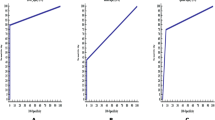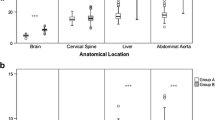Abstract
Purpose
Pancreatic injury is associated with significant morbidity and mortality. Pancreatic lacerations can be challenging to identify as the pancreas is not scanned at peak enhancement in most trauma CT protocols. This study qualitatively and quantitively assessed pancreatic lacerations with virtual monoenergetic dual-energy CT (DE CT) to establish an optimal energy level for visualization of pancreatic lacerations.
Methods
Institutional review board approval was obtained. We retrospectively examined 17 contrast-enhanced CT studies in patients with blunt trauma with MRCP, ERCP, or surgically proven pancreatic lacerations. All studies were performed in our Emergency Department from 2016 to 2019 with a 128 slice dual-source DE CT scanner. Conventional 120 kVp and noise-optimized virtual monoenergetic imaging (VMI) datasets were created. VMI energy levels were constructed from 40 to 100 keV in 10 keV increments and analyzed quantitatively and qualitatively. Pancreatic laceration attenuation, background parenchymal attenuation, and noise were calculated. Qualitative assessment was performed by two independent readers.
Results
The optimal CNR for the assessment of pancreatic lacerations was observed at VMI-40 in comparison with standard reconstructions and the remaining VMI energy levels (p = 0.001). Readers reported improved contrast resolution, diagnostic confidence, and laceration conspicuity at VMI at 40 keV (p = 0.016, p = 0.002, and p = 0.0012 respectively). However, diagnostic acceptability and subjective noise were improved on conventional polyenergentic images (p = 0.0006 and p = 0.001 respectively).
Conclusion
Dual energy CT at VMI-40 maximizes the CNR of pancreatic laceration, improves diagnostic confidence, and increases laceration conspicuity.



Similar content being viewed by others
References
Daly KP, Ho CP, Persson DL et al (2008) Traumatic retroperitoneal injuries: review of multidetector CT findings. Radiographics 28:1571–1590
Stawicki SP, Schwab CW (2008) Pancreatic trauma: demographics, diagnosis, and management. Am Surg 74:1133–1145
Lin BC, Chen RJ, Fang JF et al (2004) Management of blunt major pancreatic injury. J Trauma Acute Care Surg 56:774–778
Goshima S, Kanematsu M, Kondo H et al (2006) Pancreas: optimal scan delay for contrast-enhanced multi–detector row CT. Radiology 241:167–174
Paolantonio P, Rengo M, Ferrari R et al (2016) Multidetector CT in emergency radiology: acute and generalized non-traumatic abdominal pain. Br J Radiol 89:20150859
Murray N, Darras KE, Walstra F et al (2019) Dual-energy CT in evaluation of the acute abdomen. RadioGraphics 39:264–286
Marin D, Nelson RC, Schindera ST et al (2009) Low-tube-voltage, high-tube-current multidetector abdominal CT: improved image quality and decreased radiation dose with adaptive statistical iterative reconstruction algorithm—initial clinical experience. Radiology 254:145–153
Silva AC, Morse BG, Hara AK et al (2011) Dual-energy (spectral) CT: applications in abdominal imaging. Radiographics 31:1031–1050
Yu L, Christner JA, Leng S et al (2011) Virtual monochromatic imaging in dual-source dual-energy CT: radiation dose and image quality. Med Phys 38:6371–6379
Darras KE, Clark SJ, Kang H et al (2019) Virtual monoenergetic reconstruction of contrast-enhanced CT scans of the abdomen and pelvis at 40 keV improves the detection of peritoneal metastatic deposits. Abdom Radiol 15(44):422–428
Wang Q, Shi G, Qi X et al (2014) Quantitative analysis of the dual-energy CT virtual spectral curve for focal liver lesionscharacterization. Eur J Radiol 83:1759–1764
Hou WS, Wu HW, Yin Y et al (2015) Differentiation of lung cancers from inflammatory masses with dual-energy spectral CT imaging. Acad Radiol 22:337–344
Albrecht MH, Scholtz JE, Husers K et al (2016) Advanced imagebased virtual monoenergetic dual-energy CT angiography of the abdomen: optimization of kiloelectron volt settings to improve image contrast. Eur Radiol 26:1863–1870
Sun EX, Wortman JR, Uyeda JW et al (2019) Virtual monoenergetic dual-energy CT for evaluation of hepatic and splenic lacerations. Emerg Radiol 8:1–7
Huda W, Ogden KM, Khorasani MR (2008) Converting dose length product to effective dose at CT. Radiology 248:995–1003
Yamada Y, Jinzaki M, Hosokawa T et al (2014) Abdominal CT: an intra-individual comparison between virtual monochromatic spectral and polychromatic 120-kVp images obtained during the same examination. Eur J Radiol 83:1715–1722
De Cecco CN, Caruso D, Schoepf UJ et al (2016) Optimization of window settings for virtual monoenergetic imaging in dual-energy CT of the liver: a multi-reader evaluation of standard monoenergetic and advanced imaged-based monoenergetic datasets. Eur J Radiol 85:695–699
Darras KE, McLaughlin PD, Kang H et al (2016) Virtual monoenergetic reconstruction of contrast-enhanced dual energy CT at 70 keV maximizes mural enhancement in acute small bowel obstruction. Eur J Radiol 85:950–956
Shuman WP, Green DE, Busey JM et al (2014) Dual-energy liver CT: effect of monochromatic imaging on lesion detection, conspicuity, and contrast-to-noise ratio of hypervascular lesions on late arterial phase. Am J Roentgenol 203:601–606
Martin SS, Pfeifer S, Wichmann JL et al (2017) Noise-optimized virtual monoenergetic dual-energy computed tomography: optimization of kiloelectron volt settings in patients with gastrointestinal stromal tumors. Abdom Radiol 42:718–726
Martin SS, Wichmann JL, Weyer H et al (2017) Dual-energy computed tomography in patients with cutaneous malignant melanoma: comparison of noise-optimized and traditional virtual monoenergetic imaging. Eur J Radiol 95:1–8
De Cecco CN, Caruso D, Schoepf UJ et al (2018) A noise-optimized virtual monoenergetic reconstruction algorithm improves the diagnostic accuracy of late hepatic arterial phase dual-energy CT for the detection of hypervascular liver lesions. Eur Radiol 28:3393–3404
Lenga L, Czwikla R, Wichmann JL et al (2018) Dual-energy CT in patients with colorectal cancer: Improved assessment of hypoattenuating liver metastases using noise-optimized virtual monoenergetic imaging. Eur J Radiol 106:184–191
Rekhi S, Anderson SW, Rhea JT et al (2010) Imaging of blunt pancreatic trauma. Emerg Radiol 17:13
Grant KL, Flohr TG, Krauss B et al (2014) Assessment of an advanced image-based technique to calculate virtual monoenergetic computed tomographic images from a dual-energy examination to improve contrast-to-noise ratio in examinations using iodinated contrast media. Investig Radiol 49:586–592
Fu W, Marin D, Ramirez‐Giraldo JC, Choudhury KR et al (2017) Optimizing window settings for improved presentation of virtual monoenergetic images in dual‐energy computed tomography. Med Phys 4411:5686–5696
Author information
Authors and Affiliations
Contributions
Conceptualization: Gavin Sugrue and John Walsh. Methodology: Gavin Sugrue, John Walsh Yilin Zhang, and Bonnie Niu. Formal analysis and investigation: Gavin Sugrue, John Walsh Omar Metwally, and Francesco Macri. Writing—original draft preparation: Gavin Sugrue and Elina Khasanova. Writing—review and editing: Gavin Sugrue, John Walsh, and Omar Metwally. Supervision: Savvas Nicolaou and Nicolas Murray.
Corresponding author
Ethics declarations
Conflict of interest
Dr. Savvas Nicolaou: Research grant, Siemens.
Availability of data and material
All our data and materials as well as software application or custom code support our published claims and comply with field standards.
Code availability (software application or custom code)
Not applicable.
Authors disclosures
Gavin Sugrue, MD: none; John Walsh, MD: none; Yilin Zhang: none; Bonnie Niu, BSc: none; Francesco Macri, MD: none; Elina Khasanova, MD: none; Omar Metwally, MD: none; Nicolas Murray, MD: none; Savvas Nicolaou, MD: Institutional research grant from Siemens Healthineers.
Ethical approval
Institutional review board approved the study.
Additional information
Publisher’s note
Springer Nature remains neutral with regard to jurisdictional claims in published maps and institutional affiliations.
Rights and permissions
About this article
Cite this article
Sugrue, G., Walsh, J.P., Zhang, Y. et al. Virtual monochromatic reconstructions of dual energy CT in abdominal trauma: optimization of energy level improves pancreas laceration conspicuity and diagnostic confidence. Emerg Radiol 28, 1–7 (2021). https://doi.org/10.1007/s10140-020-01791-4
Received:
Accepted:
Published:
Issue Date:
DOI: https://doi.org/10.1007/s10140-020-01791-4




